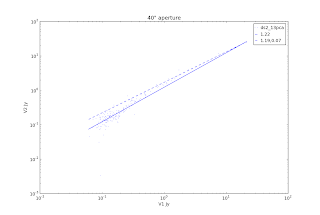| Date: | 2011-08-30 21:04 |
|---|---|
| Author: | Adam (adam.g.ginsburg@gmail.com) |
| tags: | googlepost, bolocat, version comparison |
| slug: | bolocat-v1-v2-comparison-with-new-calibration |
I re-examined the Bolocat data on l351 after re-running the pipeline with the new calibration curve. The change wasn't all that great. See this post for a brief description of the procedure. In the data below, I've fit the residuals as a function of v1.0.2 flux density in an aperture (source mask) with a line. The slope of the line should ideally be zero - that would indicate a multiplicative offset is an acceptable correction. Nicely, in the 40" aperture case, I see no reason to exclude the m=0 case. For the most reliable data - the 13pca - the slope is rather small and the "correction factor" is disturbingly close to what we recommended (1.5). We have no right to be that lucky...
...and so perhaps wer are not. The source mask includes more area and therefore is more sensitive to extended flux recovery. The slopes are not consistent with 0 - just look at the data above and below 2 Jy to see that there is a difference. The multiplicative correction of 1.5 is decent for a pretty wide range of flux densities, but is inadequate for the brightest sources. This is somewhat interesting... it implies that the brightest sources also lie on the highest backgrounds.
You might note that the brightest source has a smaller correction factor in both apertures. It's not clear why that is the case, but I don't think it's enough to call it a trend yet - wait for the full 8000-source comparison first. Why is there so much scatter? Not entirely clear, but the scatter is primarily at low S/N.
Here are the same for all of the data reduced up to this point:







